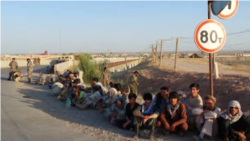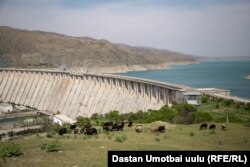
For any Central Asia governments that thought they had time to consider their policies toward Afghanistan while the last foreign troops are withdrawing from the country, the clock already seems to have run out.
Few could have foreseen the rapid advances Taliban fighters have made in northern Afghanistan since the start of May. The fighting has spread swiftly to Afghanistan's northern borders and already involves Central Asia.
The defeat on June 22 of Afghan government forces at the town of Shir Khan Bandar, with its vital border crossing into Tajikistan, seems to have been as much of a shock to Central Asian authorities as it was to the 134 Afghan soldiers who escaped the Taliban assault by fleeing into Tajikistan.
Adding to the alarm, Uzbekistan’s Foreign Ministry has confirmed that 53 armed Afghan troops and allied militia fighters also fled into Uzbekistan on June 23.
Tashkent says that after questioning those soldiers and militia fighters, Uzbek authorities sent them back.
Uptick In Fighting
Eight Afghan provinces border former Soviet republics in Central Asia. From west to east, they are Herat, Badghis, Faryab, Jowzjan, Balkh, Kunduz, Takhar, and Badakhshan.
Those provinces were relatively peaceful for most of the decade after U.S. troops first arrived in Afghanistan in late 2001. There was little cause for concern in neighboring Turkmenistan, Uzbekistan, and Tajikistan.
But Afghan security forces have become increasingly involved in fighting the Taliban and other militants since 2013. At times, some battles have taken place just across the border from Turkmenistan and Tajikistan. Stray rounds of artillery and gunfire have even occasionally landed in their territory.
RFE/RL’s Turkmen Service, known locally as Azatlyk, reported on June 25 that the Afghan town of Andkhoy in Faryab Province had fallen to the Taliban the previous day.
Reports suggest government forces on June 25 were staging counter attacks on Andkhoy, which is just 10 kilometers from Turkmenistan.
The nearby town of Aqina, about 30 kilometers from the Turkmen border, is the location of a dry port and railway station for the only railway connection between Afghanistan and Turkmenistan. It also is a key link for the Lapis Lazuli transit route that connects Afghanistan with Turkey and Europe.
Afghanistan’s private Tolo News reported on June 19 that Taliban forces captured Faryab’s Khwaja Sabz Posh district. Fighting also was reported outside the provincial capital Maimana.
In the neighboring province of Badghis, fighting in the districts of Murghab and Gormach has been going on since 2014.
In February 2014, militants crossed the Murghab River into Turkmenistan and killed three Turkmen border guards. Months later, militants crossed the border from the Gormach district -- killing three Turkmen soldiers and stealing their weapons.
In Jowzjan Province, to the east of Faryab, there are reports that the districts of Hamyab and Qarqin on the border of Turkmenistan have fallen under the control of the Taliban along with the districts of Aqcha, Mangijal, Faizabad, and Mardyan.
The town of Shir Khan Bandar, from where Afghan troops fled across a 700-meter-long bridge to Tajikistan, is in Kunduz Province.
In 2015 and again in 2016, Taliban forces temporarily seized parts of the provincial capital, Kunduz city, before they were forced out by Afghan counterattacks supported by U.S. air strikes and special forces.
All three districts of Kunduz Province that border Tajikistan -- the Imam Sahib district where Shir Khan Bandar is located, Dasht-e Archi, and Qala-e-Zal -- reportedly were under Taliban control on June 25.
The province's southern-most district of Aliabad also reportedly was captured by Taliban militants. But a report from Afghanistan’s Tolo News said Aliabad had been retaken by government forces.
Tolo News reported on June 21 that eight of the 12 districts of Takhar Province, just east of Kunduz, had either fallen to the Taliban or been evacuated by Afghan security forces during the previous week.
Those districts include Chal, Baharak, Ishkamish, Namak (Chah) Ab, Yangi Qala, Khwaja Ghar, and Hazar Samooch.
That report said Khwaja Ghar and another district, Bangi, were soon recaptured by government forces.
WATCH: Tajikistan Tense As Fighting In Afghanistan Approaches Border
Yangi Qala and Nama (Chah) Ab both border Tajikistan as does the district of Darqad, which has been under Taliban control for several years.
Takhar's provincial capital, Taloqan, was also reportedly under siege from Taliban forces.
Between the provinces bordering Turkmenistan and Tajikistan is Balkh Province -- the only Afghan province bordering Uzbekistan. With its capital of Mazar-e Sharif, most of Balkh Province has long held out against Taliban incursions.
But the 53 soldiers and militia fighters who fled into Uzbekistan on June 23 crossed from Balkh's Shortepa district.
Uzbekistan's Foreign Ministry’s statement did not elaborate on why the group crossed into Uzbek territory.
At the time, there were no reports of fighting in the Shortepa district. But there have been recent reports of fighting in Balkh Province further to the south of the Uzbek border.
Deals With The Taliban
The Taliban briefly seized the province’s Balkh district on June 12. But government forces recaptured the territory by June 22.
Other districts in the province like Chimtal, just southwest of Balkh district, also have seen fighting in recent weeks.
As Tajikistan, Turkmenistan, and Uzbekistan watch these events unfold, their governments have surely seen reports of retreats by Afghan government forces.
In some cases, security forces have simply run out of ammunition or failed to receive reinforcements. Other times, they've reached deals with advancing Taliban -- leaving their weapons and other equipment behind in exchange for safe passage.
WATCH: Amid Taliban Offensive, Afghan Civilians Are Taking Up Arms
There is now little room for optimism that Afghan government forces can hold out long against the Taliban in northern Afghanistan, especially after September 11 when the last foreign troops are due to leave.
The government in Kabul already has signaled that it wants paramilitary forces to play a larger role in the fight against the Taliban.
But that raises a familiar old problem for the Tajik and Uzbek governments.
During the latter half of the 1990s, when Taliban fighters were advancing across much of northern Afghanistan, Uzbekistan threw its support behind the ethnic-Uzbek Afghan commander Abdul Rashid Dostum -- a controversial figure often described as a warlord.
Tajikistan threw its support behind ethnic Tajik commander Ahmad Shah Masud -- the legendary "Lion Of Panjshir."
Now, with Afghan government forces on the backfoot, there may be elements in Tashkent and Dushanbe looking for Afghan proxies to guard the doorstep of their countries.
Their concerns may not be so much about the Taliban, but rather, about radicalized Islamists from Tajikistan and Uzbekistan who are fighting in the ranks of the Taliban or other militant groups.
Most concerning to them are their citizens among groups like the Islamic State of Khorasan, or Central Asian extremist groups that now operate in Afghanistan -- the Tajik-dominated Jamaat Ansarullo or Uzbek-dominated groups, the Islamic Jihad Union, Katibat Imam al-Bukhari, Katibat Tahwid al-Jihad, or the remnants of the Islamic Movement of Uzbekistan.
Turkmenistan, with its official policy of neutrality, has always tried to stay out of Afghanistan’s internal conflicts.
In March 2019, when about 100 government soldiers attempted to flee into Turkmenistan to escape a Taliban advance in the Murghab district of Badghis Province, they were turned back by Turkmen border guards. That subsequently led to their capture by the Taliban.
Four years earlier, Turkmen border guards turned back a group of Taliban fighters who were fleeing an attack by fighters under the command of General Abdul Rashid Dostum in the Hamyab district of Jowzjan Province.
Uzbekistan now seems to be trying to follow this model -- judging by its decision to return the 53 pro-government fighters back into Afghanistan.
In contrast, Dushanbe this week allowed fleeing Afghan troops to remain temporarily in Tajikistan. The wounded were treated at hospitals there.
The head of Tajikistan’s eastern Gorno-Badakhshan region, Yodgor Fayzov, told a meeting of regional administrators on June 21 that they should be prepared to take in at least 5,000 and as many as 10,000 refugees from Afghanistan.
As the situation continues to unfold on the Afghan side of the border, the governments of Tajikistan, Turkmenistan, and Uzbekistan are also likely to be double-checking the bilateral and multilateral defense and security agreements they have -- just in case.












